Predictions & Data for this entry
| Model: sbp | climate: A, C | migrate: | phylum: |
| COMPLETE = 3.2 | ecozone: TN | food: biHe | class: |
| MRE = 0.104 | habitat: 0iTg | gender: D | order: |
| SMSE = 0.026 | embryo: Thl | reprod: O | family: |
Zero-variate data
| Data | Observed | Predicted | (RE) | Unit | Description | Reference |
|---|---|---|---|---|---|---|
| ab | 6 | 5.806 | (0.03235) | d | age at birth | GuilGome2015 |
| ap | 31.4 | 30.74 | (0.02111) | d | age at puberty | GuilGome2015 |
| am | 120 | 122 | (0.01685) | d | life span as imago | MalaPani1999 |
| Lhb | 0.055 | 0.05087 | (0.07518) | cm | head length at birth | KlagGerg2024 |
| Wwb | 0.00074 | 0.0009982 | (0.3489) | g | wet weight at birth | MalaPani1999 |
| Wwp | 0.07285 | 0.04656 | (0.3608) | g | wet weight at puberty | MalaPani1999 |
| Ri | 4.133 | 3.66 | (0.1144) | #/d | maximum reprod rate | MichMora2019 |
| t1 | 3.1 | 2.921 | (0.05779) | d | duration of instar 1 | GuilGome2015 |
| t2 | 6 | 5.996 | (0.000741) | d | duration of instar 2 | GuilGome2015 |
| t3 | 3.5 | 3.488 | (0.003351) | d | duration of instar 3 | GuilGome2015 |
| t4 | 4.7 | 4.612 | (0.01878) | d | duration of instar 4 | GuilGome2015 |
| t5 | 8.1 | 7.915 | (0.02286) | d | duration of instar 5 | GuilGome2015 |
| JC_p | 0.0287 | 0.02745 | (0.04349) | ml CO2/h | respiration rate | HaddMend2016 |
Uni- and bivariate data
| Data | Figure | Independent variable | Dependent variable | (RE) | Reference |
|---|---|---|---|---|---|
| tL_fB1 | 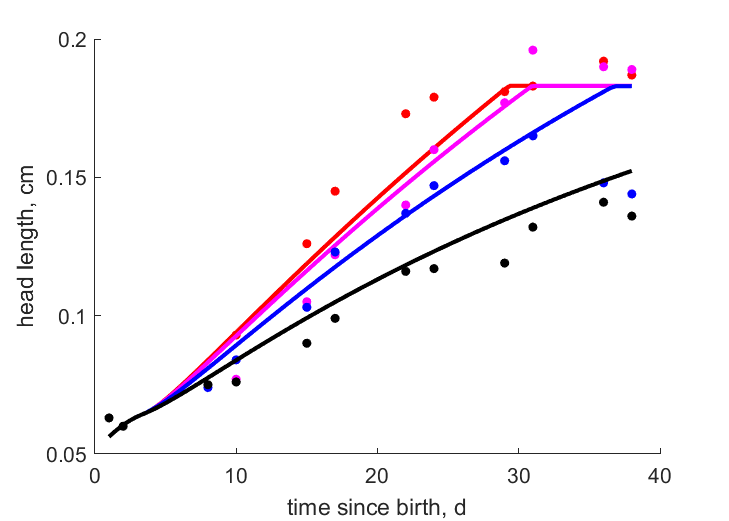  | time since birth | head length | (0.0577) | KlagGerg2024 |
| tL_fB2 |   | time since birth | head length | (0.05498) | KlagGerg2024 |
| tL_fB3 |   | time since birth | head length | (0.08055) | KlagGerg2024 |
| tL_fB4 |   | time since birth | head length | (0.0717) | KlagGerg2024 |
| tWw_fB1 | 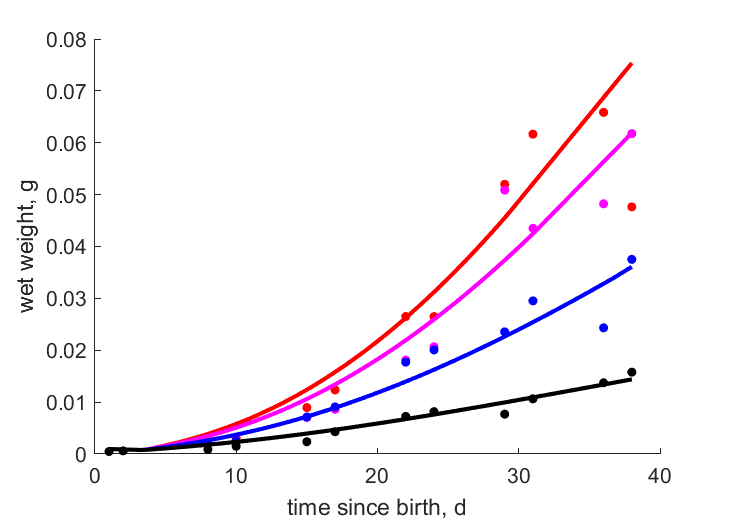 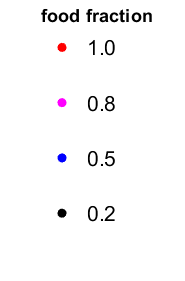 | time since birth | wet weight | (0.2053) | KlagGerg2024 |
| tWw_fB2 |   | time since birth | wet weight | (0.1706) | KlagGerg2024 |
| tWw_fB3 |   | time since birth | wet weight | (0.1449) | KlagGerg2024 |
| tWw_fB4 |   | time since birth | wet weight | (0.1342) | KlagGerg2024 |
| Tab | 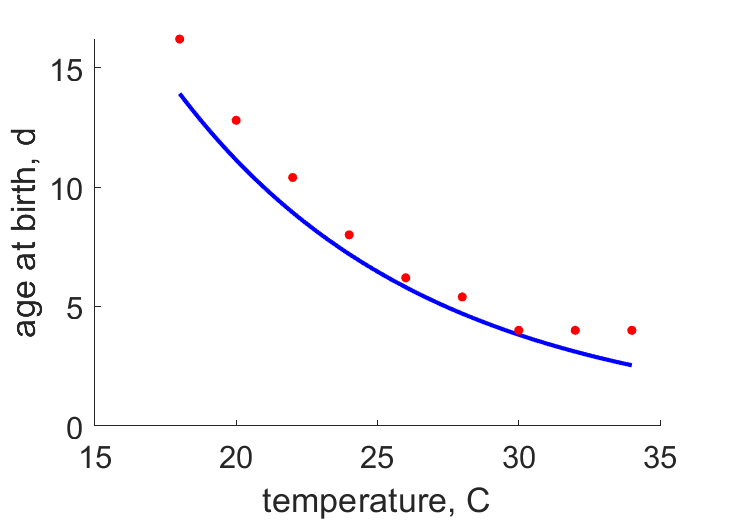 | temperature | age at birth | (0.1388) | KlagGerg2024 |
| Ttins | 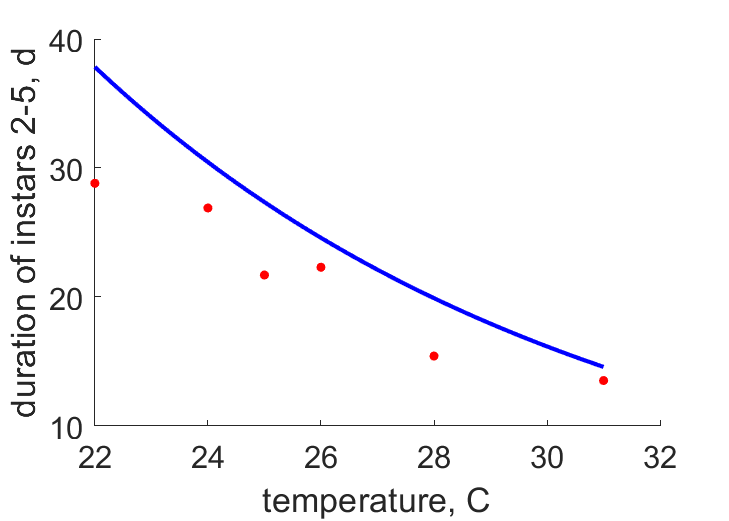 | temperature | duration of instars 2-5 | (0.2026) | GuilGome2015, MalaPani1999, CostBorg1998, Frug2015 |
| tN | 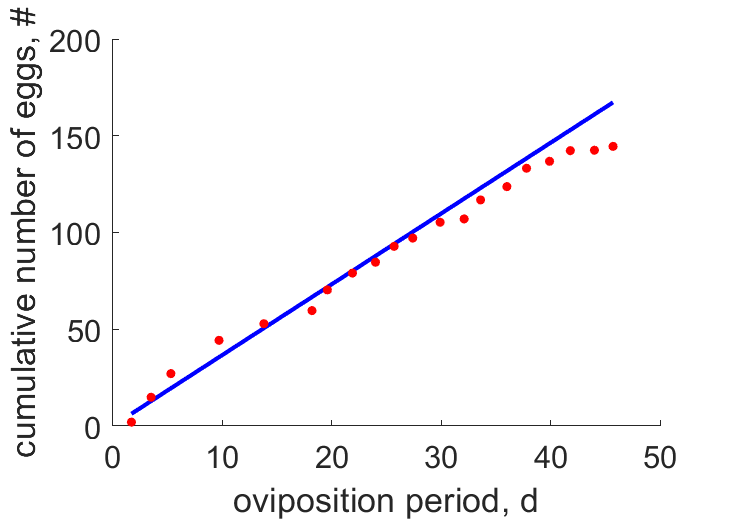 | oviposition period | cumulative number of eggs | (0.07733) | HaddMend2016 |
| tS | 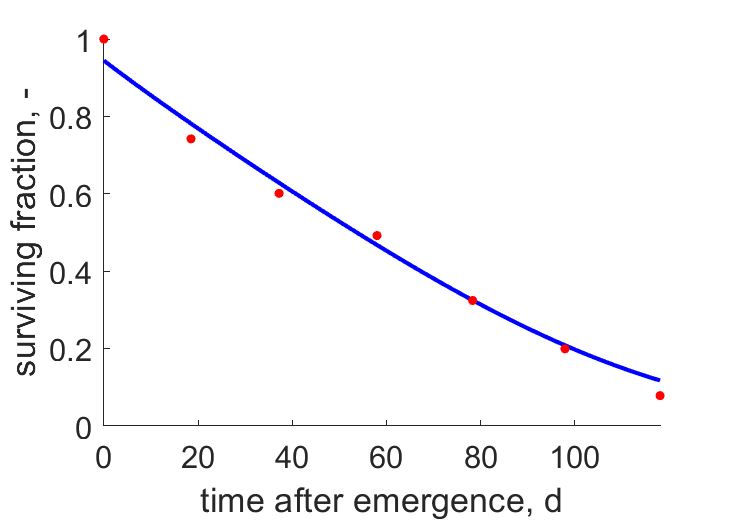 | time after emergence | surviving fraction | (0.05708) | MalaPani1999 |
| tSN | 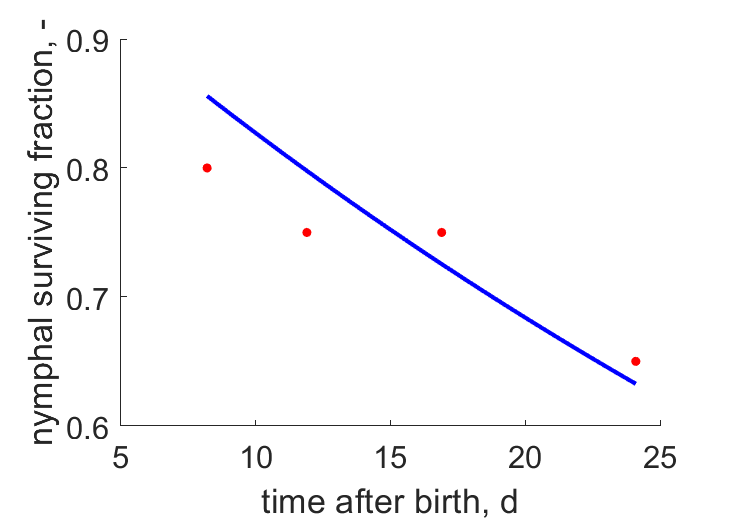 | time after birth | nymphal surviving fraction | (0.04938) | MalaPani1999 |
Pseudo-data at Tref = 20°C
| Data | Generalised animal | Euschistus heros | Unit | Description |
|---|---|---|---|---|
| v | 0.02 | 0.01545 | cm/d | energy conductance |
| p_M | 18 | 530.6 | J/d.cm^3 | vol-spec som maint |
| k_J | 0.002 | 0.1156 | 1/d | maturity maint rate coefficient |
| k | 0.99 | 0.9704 | - | maintenance ratio |
| kap | 0.8 | 0.843 | - | allocation fraction to soma |
| kap_G | 0.8 | 0.7984 | - | growth efficiency |
| kap_R | 0.95 | 0.95 | - | reproduction efficiency |
Discussion
- abp model also works well for this species
- Biological observations show that length at which stage transitions occur does not change much across different levels of food availability for many insect species.
- The selection of the mainenance ratio k=0.99 as pseudo-data, is based on the implied property of the model that when k=1, stage transitions occur at fixed structural length. This property aligns with observationsin D2
- First instar nymphs do not eat, they are modeled as non-feeding juvenile instead of embryo. This makes sbp model more general as not all insects have a non-feeding first instar.
Facts
- During the first instar the nymph does not feed (Ref: PaniMene1989, PaniOliv1998)
Acknowledgment
- Version 2024/01/18 of this entry was financially supported by Bayer.
Bibliography